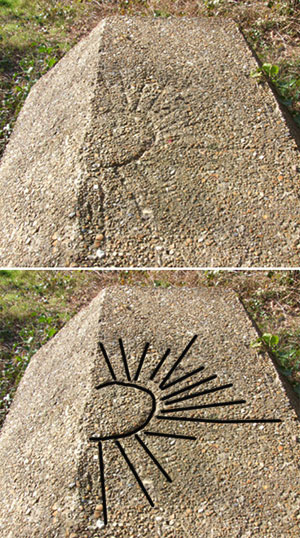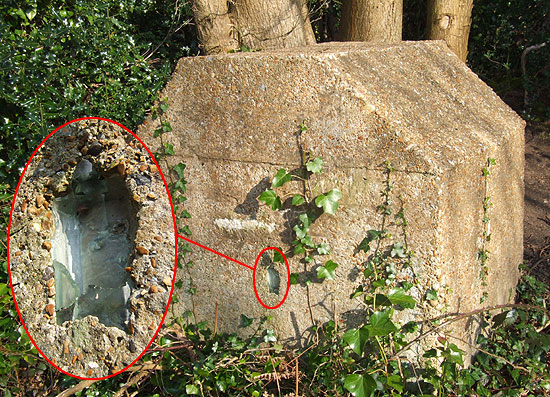Art Deco dragon's tooth
Posted: 22 April 2007 21:19
Back on 8 April, I took a second visit out to Ninfield to do some follow-up on my previous discovery of over 90 cubes.
A frequently asked question from friends and family is "Why do you keep going back to the same places?" The answer simply is that I always seem to see something new on a second or third visit; my discoveries at Cuckmere Haven are a prime example.

Another accidental discovery was due purely to the sun casting shadows across one of the dragon's teeth I had seen previously.
I saw these markings immediately, as they stood out quite well. (You can almost make them out in the photo I took last time).
When I first saw them, I thought that they might have been some sort of 'range card', a basic diagram of direction and distances to key points and features used by soldiers as a reference.
However, it was quickly clear that this was not the case and for several reasons; the radiating points didn't correspond with any significant features, and none of the garrison of the nodal point would be positioned right by the cubes to be able to see it.
It would appear that the intention was actually to create an Art Deco 'sunray' motif, perhaps inspired by the weather, or the design of fashionable garden gates of the period.
This particular cube also had a small glass bottle incorporated in its front face, something that I had previously noted on another cube at Ninfield.
As the photograph below shows, the outer side of the bottle has been broken (airgun pellet marks are present), but the rest survives intact.

- Pete

Email:
Blog Latest

Bishopstone reveals its pillbox secrets
18 October 2021

Pillbox or Observation Post?
10 June 2020

Uncovering the hidden secrets of a pillbox
8 June 2019

Review of 2018
31 December 2018

Wartime Christmas in East Sussex (2)
24 December 2018
Jargon-buster
Cubes
Anti-tanks blocks, popularly known as dragon's teeth. Not to be confused with smaller blocks known as pimples, cubes can be upwards of 1m square. Many examples in Sussex have apexes or chamfered edges, leading to them being incorrectly recorded as coffins.
Nodal Point
Defended road junction(s), usually within a village/town with a Home Guard garrison intended to deny enemy use of the roads. Nodal Points were not to defend the village, but solely the road network. Category 'A' Nodal Points were to hold out for 7 days after invasion without outside assistance.
This site is copyright © Peter Hibbs 2006 - 2024. All rights reserved.
Hibbs, Peter Art Deco dragon's tooth (2024) Available at: http://www.pillbox.org.uk/blog/216527/ Accessed: 24 April 2024
The information on this website is intended solely to describe the ongoing research activity of The Defence of East Sussex Project; it is not comprehensive or properly presented. It is therefore NOT suitable as a basis for producing derivative works or surveys!